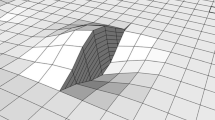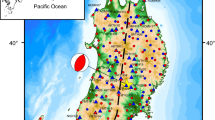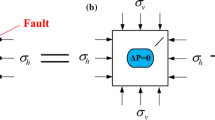Abstract
The reactivation of faults and the generation of fractures can be caused by stress changes due to injection and/or production of fluids into and/or from the subsurface. The simulation of these processes, which could be associated with (micro-)seismicity, is affected by a high uncertainty. The aim of this work is at developing a mathematical framework to quantify and possibly reduce the prior modeling uncertainties by assimilation of seismic data. The mechanics of fault (re-)activation is simulated by a Finite Element (FE) numerical model where the discontinuous displacements between the fault surfaces are suitably considered using appropriate Interface Elements (IEs). The study is carried out by using a stochastic approach, with a global sensitivity analysis (gSA) based on Sobol’ indices initially performed to estimate the influence of the input parameters on the model solution. Then, a Markov Chain Monte Carlo (MCMC) sampling technique based on the generalized Polynomial Chaos expansion (gPC) surrogate solution is used to update the prior information conditioned on seismic observations. The methodology is tested on a 3D synthetic test case. The uncertain input is the natural stress regime and the Mohr-Coulomb parameters characterizing the fault activation criterion. A good reduction of the prior uncertainty is obtained, showing that the assimilation of seismic data can have a promising potential for improving the subsurface characterization.
Similar content being viewed by others
Abbreviations
- x :
-
Cartesian coordinates of a point in the three-dimensional space
- t :
-
time/loading step variable
- y :
-
state vector of the system
- y ∗ :
-
forcing term of the system
- u :
-
vector of the model parameters
- \(\mathcal {G}\) :
-
forward problem operator
- q :
-
vector of the quantities of interest
- \(\mathcal {M}\) :
-
map from y to q
- \(\mathcal {S}\) :
-
solution operator of the forward problem
- U :
-
random vector of the model parameters
- Q :
-
random vector of the quantities of interest
- Y :
-
random vector of the model output
- ρ :
-
joint probability density function of a given random vector
- Z :
-
random vector of the model parameters defined over a unit hypercube
- V :
-
variance
- S i :
-
first order Sobol’ index
- S 1,…, s :
-
higher order Sobol’ index
- D :
-
random vector of the noisy measurements
- D t :
-
random vector of the true observable
- 𝜖 :
-
random vector of the observational error
- \(\mathcal {H}\) :
-
map from the model state to the true observable
- π :
-
conditioned probability density function
- τ L :
-
shear stress limit
- τ 0 :
-
fault cohesion
- ϕ :
-
fault friction angle
- σ n :
-
normal effective stress acting on the fault
- ϕ k :
-
k-th univariate basis function
- \(\tilde {\boldsymbol {Y}}\) :
-
gPC approximation of Y
- c α :
-
vector of coefficients of the gPC expansion
- Φα :
-
multivariate gPC basis functions
- α, β :
-
multi-index vectors
- \(\tilde {\boldsymbol {c}}_{\boldsymbol {\alpha }}\) :
-
approximation of the gPC expansion coefficients
- w :
-
integration weights
- σ 1, σ 2, σ 3 :
-
principal stresses
- M1,M2 :
-
ratio of the principal stress σ1 and σ2 to σ3
- σ :
-
effective normal stress vector
- τ :
-
shear stress vector
- s :
-
displacement field vector
- A a :
-
activated area of the fault
- δ s :
-
sliding of the fault
- k :
-
hydraulic conductivity
- p :
-
pore pressure
- δ t :
-
slippage of the fault elements
- M 0 :
-
seismic moment
- G :
-
shear modulus of the rock formation
References
Aagaard, B.T., Knepley, M.G., Williams, C.A.: A domain decomposition approach to implementing fault slip in finite-element models of quasi-static and dynamic crustal deformation. J. Geophys. Res.: Solid Earth 118(6), 3059–3079 (2013)
Baisch, S., Vörös, R., Rothert, E., Stang, H., Jung, R., Schellschmidt, R.: A numerical model for fluid injection induced seismicity at Soultz-sous-Forêts. Int. J. Rock Mech. Mining Sci. 47(3), 405–413 (2010). https://doi.org/10.1016/j.ijrmms.2009.10.001
Baù, D., Ferronato, M., Gambolati, G., Teatini, P.: Basin-scale compressibility of the Northern Adriatic by the radioactive marker technique. Geotechnique 52(8), 605–616 (2002)
Beer, G.: An isoparametric joint/interface element for finite element analysis. Int. J. Numer. Methods Eng. 21(4), 585–600 (1985)
Cappa, F., Rutqvist, J.: Modeling of coupled deformation and permeability evolution during fault reactivation induced by deep underground injection of CO2. Int. J. Greenhouse Gas Control 5(2), 336–346 (2011)
Castelletto, N., Teatini, P., Gambolati, G., Bossie-Codreanu, D., Vincké, O., Daniel, J.M., Battistelli, A., Marcolini, M., Donda, F., Volpi, V.: Multiphysics modeling of CO2 sequestration in a faulted saline formation in italy. Adv. Water Resour. 62, 570–587 (2013). https://doi.org/10.1016/j.advwatres.2013.04.006
Castiñeira, D., Jha, B., Juanes, R.: Uncertainty quantification and inverse modeling of fault poromechanics and induced seismicity: application to a synthetic carbon capture and storage (ccs) problem. ARMA-2016-151, American Rock Mechanics Association, 50th U.S Rock Mechanics/Geomechanics Symposium, 26-29, June, Houston (2016)
Cesca, S., Grigoli, F., Heimann, S., González, A.́, Buforn, E., Maghsoudi, S., Blanch, E., Dahm, T.: The 2013 September-October seismic sequence offshore Spain: a case of seismicity triggered by gas injection? Geophys. J. Int. 198(2), 941–953 (2014). https://doi.org/10.1093/gji/ggu172
Cescotto, S., Charlier, R.: Frictional contact finite elements based on mixed variational principles. Int. J. Numer. Methods Eng. 36(10), 1681–1701 (1993)
Chang, H., Chen, Y., Zhang, D.: Data assimilation of coupled fluid flow and geomechanics using the ensemble kalman filter. Soc. Petroleum Eng., 15(2). https://doi.org/10.2118/118963-PA (2010)
Constantine, P., Eldred, M., Phipps, E.: Sparse pseudospectral approximation method. Comput. Methods Appl. Mech. Eng. 229–232, 1–12 (2012). https://doi.org/10.1016/j.cma.2012.03.019
Crestaux, T., Le Maître, O., Martinez, J.M.: Polynomial chaos expansion for sensitivity analysis. Reliab. Eng. Syst. Safety 94(7), 1161–1172 (2009). https://doi.org/10.1016/j.ress.2008.10.008
Fajraoui, N., Ramasomanana, F., Younes, A., Mara, T.A., Ackerer, P., Guadagnini, A.: Use of global sensitivity analysis and polynomial chaos expansion for interpretation of nonreactive transport experiments in laboratory-scale porous media. Water Resour. Res. 47(2), W02521 (2011). https://doi.org/10.1029/2010WR009639
Ferronato, M., Gambolati, G., Janna, C., Teatini, P.: Numerical modelling of regional faults in land subsidence prediction above gas/oil reservoirs. Int. J. Numer. Anal. Methods Geomech. 32(6), 633–657 (2008)
Fokker, P.A., Wassing, B.B., van Leijen, F.J., Hanssen, R.F., Nieuwland, D.A.: Application of an ensemble smoother with multiple data assimilation to the Bergermeer gas field, using PS-InSAR. Geomech. Energy Environ. 5, 16–28 (2016). https://doi.org/10.1016/j.gete.2015.11.003
Formaggia, L., Guadagnini, A., Imperiali, I., Lever, V., Porta, G., Riva, M., Scotti, A., Tamellini, L.: Global sensitivity analysis through polynomial chaos expansion of a basin-scale geochemical compaction model. Comput. Geosci. 17(1), 25–42 (2013). https://doi.org/10.1007/s10596-012-9311-5
Franceschini, A., Castelletto, N., Ferronato, M.: Block preconditioning for fault/fracture mechanics saddle-point problems. Comput. Methods Appl. Mech. Eng. 344, 376–401 (2019). https://doi.org/10.1016/j.cma.2018.09.039
Franceschini, A., Ferronato, M., Janna, C., Teatini, P.: A novel Lagrangian approach for the stable numerical simulation of fault and fracture mechanics. J. Comput. Phys. 314, 503–521 (2016). https://doi.org/10.1016/j.jcp.2016.03.032
Franceschini, A., Teatini, P., Janna, C., Ferronato, M., Gambolati, G., Ye, S.J., Carreón-Freyre, D.: Modelling ground rupture due to groundwater withdrawal: Applications to test cases in China and Mexico. Proc. Int. Assoc. Hydrol. Sci. 372, 63 (2015)
Gan, Q., Elsworth, D.: Thermal drawdown and late-stage seismic-slip fault reactivation in enhanced geothermal reservoirs. J. Geophys. Res.: Solid Earth 119(12), 8936–8949 (2014). https://doi.org/10.1002/2014JB011323
Gan, W., Frohlich, C.: Gas injection may have triggered earthquakes in the Cogdell oil field, Texas. Proc. Natl. Acad. Sci. 110(47), 18786–18791 (2013). https://doi.org/10.1073/pnas.1311316110
Gaucher, E., Shoenball, M., Heidbach, O., Zang, A., Fokker, A.P., van Wees, J.D., Kohl, T.: Induced seismicity in geothermal reservoirs: A review of forecasting approaches. Renew. Sustain. Energy Rev. 52, 1473–1490 (2015). https://doi.org/10.1016/j.rser.2015.08.026
Hȧring, M.O., Schanz, U., Ladner, F., Dyer, B.C.: Characterisation of the Basel 1 enhanced geothermal system. Geothermics 37(5), 469–495 (2008). https://doi.org/10.1016/j.geothermics.2008.06.002
Hastings, W.K.: Monte Carlo sampling methods using Markov Chains and their applications. Biometrika 57, 97–109 (1970)
Horton, S.: Disposal of hydrofracking waste fluid by injection into subsurface aquifers triggers earthquake swarm in central Arkansas with potential for damaging earthquake. Seismol. Res. Lett. 83(2), 250–260 (2012). https://doi.org/10.1785/gssrl.83.2.250
Jha, B., Juanes, R.: Coupled multiphase flow and poromechanics: A computational model of pore pressure effects on fault slip and earthquake triggering. Water Resour. Res. 50, 3776–3808 (2014)
Kanamori, H.L., Anderson, D.: Theoretical basis of some empirically relations in seismology. Bull. Seismol. Soc. Am. 65(5), 1073–1095 (1975)
King, G.C.P., Stein, R.S., Lin, J.: Static stress changes and the triggering of earthquakes. Bull. Seismol. Soc. Am. 84(3), 935–953 (1994)
Kraaijpoel, D.A., Nieuwland, D.A., Dost, B.: Microseismic monitoring and subseismic fault detection in an underground gas storage. In:. 4th Passive Seismic Workshop, pp. 80–82 (2013)
Labuz, J.F., Zang, A.: Mohr-Coulomb failure criterion. Rock Mech. Rock. Eng. 45, 975–979 (2012). https://doi.org/10.1007/s00603
Lei, X., Ma, S., Chen, W., Pang, C., Zeng, J., Jiang, B.: A detailed view of the injection-induced seismicity in a natural gas reservoir in Zigong, southwestern Sichuan Basin, China. J. Geophys. Res.: Solid Earth 118(8), 4296–4311 (2013)
Li, H., Zhang, D.: Probabilistic collocation method for flow in porous media: Comparisons with other stochastic methods. Water Resour. Res. 43(9), 1–13 (2007). https://doi.org/10.1029/2006WR005673
Li, W., Lu, Z., Zhang, D.: Stochastic analysis of unsaturated flow with probabilistic collocation method. Water Resour. Res. 45(8), 1–13 (2009). https://doi.org/10.1029/2008WR007530
Li, Y.J., Kokkinaki, A., Darve, E.F., Kitanidis, P.K.: Smoothing-based compressed state kalman filter for joint state-parameter estimation: Applications in reservoir characterization and CO2 storage monitoring. Water Resour. Res. 53, 7190–7207 (2017). https://doi.org/10.1002/2016WR020168
Liao, Q., Zhang, D.: Probabilistic collocation method for strongly nonlinear problems: 3. Transform by time. Water Resour. Res. 52, 2366–2375 (2016). https://doi.org/10.1002/2015WR017724
Mazzoldi, A., Rinaldi, A.P., Borgia, A., Rutqvist, J.: Induced seismicity within geological carbon sequestration projects: Maximum earthquake magnitude and leakage potential from undetected faults. Int. J. Greenhouse Gas Control 10, 434–442 (2012). https://doi.org/10.1016/j.ijggc.2012.07.012
Metropolis, N., Rosenbluth, A.W., Rosenbluth, M.N., Teller, A.H., Teller, E.: Equation of state calculations by fast computing machines. J. Chem. Phys. 21, 1087–1092 (1953). https://doi.org/10.1063/1.1699114
Nicol, A., Carne, R., Gerstenberger, M., Christophersen, A.: Induced seismicity and its implications for CO2 storage risk. Energy Procedia 4, 3699–3706 (2011). https://doi.org/10.1016/j.egypro.2011.02.302
Ochoa-Gonzalez, G., Carreon-Freyre, D., Franceschini, A., Cerca, M., Teatini, P.: Overexploitation of groundwater resources in the faulted basin of Queretaro, Mexico: A 3D deformation and stress analysis. Eng. Geol. 245, 192–206 (2018). https://doi.org/10.1016/j.enggeo.2018.08.014
Orlic, B., Wassing, B., Geel, C.: Field scale geomechanical modeling for prediction of fault stability during underground gas storage operations in a depleted gas field in the netherlands. ARMA-2013-300, American Rock Mechanics AssociationSource 47th U.S Rock Mechanics/Geomechanics Symposium, 23-26 June, San Francisco, California (2013)
Phillips, W., Rutledge, J., House, L., Fehler, M.: Induced microearthquake patterns in hydrocarbon and geothermal reservoirs: Six case studies. Pure Appl. Geophys. 159(1), 345–369 (2002). https://doi.org/10.1007/pl00001256
Priolo, E., Romanelli, M., Plasencia Linares, M.P., Garbin, M., Peruzza, L., Romano, M.A., Marotta, P., Bernardi, P., Moratto, L., Zuliani, D., Fabris, P.: Seismic monitoring of an underground natural gas storage facility: The collalto seismic network. Seismol. Res. Lett. 86(1), 109–123 (2015). https://doi.org/10.1785/0220140087
Rutqvist, J., Birkholzer, J., Tsang, C.: Coupled reservoir-geomechanical analysis of the potential for tensile and shear failure associated with 2 injection in multilayered reservoir-caprock systems. Int. J. Rock Mech. Min. Sci 45, 132–143 (2008)
Saltelli, A., Marco, R., Andres, T., Campolongo, F., Cariboni, J., Gatelli, D., Saisana, M., Tarantola, S.: Global Sensitivity Analysis. The Primer. Wiley, Chichester (2007)
Sobol’, I.: Sensitivity estimates for nonlinear mathematical models. Matematicheskoe Modelirovanie 2, 112–118 (1990). (1990 in Russian, translated in English in Sobol’ (1993))
Sudret, B.: Meta-models for structural reliability and uncertainty quantification. In: Proc. 5th Asian-Pacific Symp. Struct. Reliab. (APSSRA’2012) Singapore, pp. 53–76. https://doi.org/10.3850/981-973-0000-00-0 (2012)
Teatini, P., Baù, D., Gambolati, G.: Water-gas dynamics and coastal subsidence over chioggia mare field, northern adriatic sea. Hydrogeol. J. 8(5), 462–479 (2000)
Verdon, J.P., Kendall, J.M., White, D.J., Angus, D.A.: Linking microseismic event observations with geomechanical models to minimise the risks of storing CO2 in geological formations. Earth Planet. Sci. Lett. 305(1-2), 143–152 (2011). https://doi.org/10.1016/j.epsl.2011.02.048
White, J.A., Foxall, W.: Assessing induced seismicity risk at CO2 storage projects: Recent progress and remaining challenges. Inte. J. Greenhouse Gas Control 49, 413–424 (2016). https://doi.org/10.1016/j.ijggc.2016.03.021
Wiener, N.: The homogeneous chaos. Am. J. Math. 60(4), 897–936 (1938). https://doi.org/10.2307/2371268
Wriggers, P.: Contact Mechanics. Springer, Berlin (2005)
Xiu, D.: Efficient collocational approach for parametric uncertainty analysis. Commun. Comput. Phys. 2(2), 293–309 (2007)
Xiu, D.: Numerical Methods for Stochastic Computations. A Spectral Method Approach. Princeton University Press, Princeton (2010)
Xiu, D., Karniadakis, G.: The Wiener-Askey polynomial chaos for stochastic differential equations. SIAM J. Sci. Comput. 24(2), 619–644 (2002)
Ye, S., Franceschini, A., Zhang, Y., Janna, C., Gong, X., Yu, J., Teatini, P.: A novel approach to model earth fissure caused by extensive aquifer exploitation and its application to the Wuxi case, China. Water Resour. Res. 54(3), 2249–2269 (2018). https://doi.org/10.1002/2017WR021872
Zander, E.K.: Sglib - a matlab/octave toolbox for stochastic galerkin and stochastic collocation methods, http://ezander.github.io/sglib/
Zang, A., Oye, V., Jousset, P., Deichmann, N., Gritto, R., McGarr, A., Majer, E., Bruhn, D.: Analysis of induced seismicity in geothermal reservoirs - An overview. Geothermics 52, 6–21 (2014). https://doi.org/10.1016/j.geothermics.2014.06.005
Zoback, M.D., Gorelick, S.M.: Earthquake triggering and large-scale geologic storage of carbon dioxide. Proc. Natl. Acad. Sci. 109(26), 10164–10168 (2012). https://doi.org/10.1073/pnas.1202473109
Zoccarato, C., Bau̇, D., Ferronato, M., Gambolati, G., Alzraiee, A., Teatini, P.: Data assimilation of surface displacements to improve geomechanical parameters of gas storage reservoirs. J. Geophys. Res.: Solid Earth 121(3), 1441–1461 (2016). https://doi.org/10.1002/2015JB012090
Acknowledgments
The research has been carried out in the framework of the UNESCO IGCP 641 project “Mechanisms, Monitoring and Modeling Earth Fissure generation and Fault activation due to subsurface Fluid exploitation (M3EF3)”.
Funding
This work has been partially funded by the University of Padova project “Data Assimilation algorithms for reservoir geomechanics and induced seismicity.”
Author information
Authors and Affiliations
Corresponding author
Additional information
Publisher’s note
Springer Nature remains neutral with regard to jurisdictional claims in published maps and institutional affiliations.
Rights and permissions
About this article
Cite this article
Zoccarato, C., Ferronato, M., Franceschini, A. et al. Modeling fault activation due to fluid production: Bayesian update by seismic data. Comput Geosci 23, 705–722 (2019). https://doi.org/10.1007/s10596-019-9815-3
Received:
Accepted:
Published:
Issue Date:
DOI: https://doi.org/10.1007/s10596-019-9815-3




